| 1 | // Copyright 2014 The Flutter Authors. All rights reserved. |
|---|---|
| 2 | // Use of this source code is governed by a BSD-style license that can be |
| 3 | // found in the LICENSE file. |
| 4 | |
| 5 | /// @docImport 'package:flutter/material.dart'; |
| 6 | /// |
| 7 | /// @docImport 'box_decoration.dart'; |
| 8 | library; |
| 9 | |
| 10 | import 'dart:collection'; |
| 11 | import 'dart:math' as math; |
| 12 | import 'dart:ui' as ui show Gradient, lerpDouble; |
| 13 | |
| 14 | import 'package:flutter/foundation.dart'; |
| 15 | import 'package:vector_math/vector_math_64.dart'; |
| 16 | |
| 17 | import 'alignment.dart'; |
| 18 | import 'basic_types.dart'; |
| 19 | |
| 20 | class _ColorsAndStops { |
| 21 | _ColorsAndStops(this.colors, this.stops); |
| 22 | final List<Color> colors; |
| 23 | final List<double> stops; |
| 24 | } |
| 25 | |
| 26 | /// Calculate the color at position [t] of the gradient defined by [colors] and [stops]. |
| 27 | Color _sample(List<Color> colors, List<double> stops, double t) { |
| 28 | assert(colors.isNotEmpty); |
| 29 | assert(stops.isNotEmpty); |
| 30 | if (t <= stops.first) { |
| 31 | return colors.first; |
| 32 | } |
| 33 | if (t >= stops.last) { |
| 34 | return colors.last; |
| 35 | } |
| 36 | final int index = stops.lastIndexWhere((double s) => s <= t); |
| 37 | assert(index != -1); |
| 38 | return Color.lerp( |
| 39 | colors[index], |
| 40 | colors[index + 1], |
| 41 | (t - stops[index]) / (stops[index + 1] - stops[index]), |
| 42 | )!; |
| 43 | } |
| 44 | |
| 45 | _ColorsAndStops _interpolateColorsAndStops( |
| 46 | List<Color> aColors, |
| 47 | List<double> aStops, |
| 48 | List<Color> bColors, |
| 49 | List<double> bStops, |
| 50 | double t, |
| 51 | ) { |
| 52 | assert(aColors.length >= 2); |
| 53 | assert(bColors.length >= 2); |
| 54 | assert(aStops.length == aColors.length); |
| 55 | assert(bStops.length == bColors.length); |
| 56 | final SplayTreeSet<double> stops = |
| 57 | SplayTreeSet<double>() |
| 58 | ..addAll(aStops) |
| 59 | ..addAll(bStops); |
| 60 | final List<double> interpolatedStops = stops.toList(growable: false); |
| 61 | final List<Color> interpolatedColors = interpolatedStops |
| 62 | .map<Color>( |
| 63 | (double stop) => |
| 64 | Color.lerp(_sample(aColors, aStops, stop), _sample(bColors, bStops, stop), t)!, |
| 65 | ) |
| 66 | .toList(growable: false); |
| 67 | return _ColorsAndStops(interpolatedColors, interpolatedStops); |
| 68 | } |
| 69 | |
| 70 | /// Base class for transforming gradient shaders without applying the same |
| 71 | /// transform to the entire canvas. |
| 72 | /// |
| 73 | /// For example, a [SweepGradient] normally starts its gradation at 3 o'clock |
| 74 | /// and draws clockwise. To have the sweep appear to start at 6 o'clock, supply |
| 75 | /// a [GradientRotation] of `pi/4` radians (i.e. 45 degrees). |
| 76 | @immutable |
| 77 | abstract class GradientTransform { |
| 78 | /// Abstract const constructor. This constructor enables subclasses to provide |
| 79 | /// const constructors so that they can be used in const expressions. |
| 80 | const GradientTransform(); |
| 81 | |
| 82 | /// When a [Gradient] creates its [Shader], it will call this method to |
| 83 | /// determine what transform to apply to the shader for the given [Rect] and |
| 84 | /// [TextDirection]. |
| 85 | /// |
| 86 | /// Implementers may return null from this method, which achieves the same |
| 87 | /// final effect as returning [Matrix4.identity]. |
| 88 | Matrix4? transform(Rect bounds, {TextDirection? textDirection}); |
| 89 | } |
| 90 | |
| 91 | /// A [GradientTransform] that rotates the gradient around the center-point of |
| 92 | /// its bounding box. |
| 93 | /// |
| 94 | /// {@tool snippet} |
| 95 | /// |
| 96 | /// This sample would rotate a sweep gradient by a quarter turn clockwise: |
| 97 | /// |
| 98 | /// ```dart |
| 99 | /// const SweepGradient gradient = SweepGradient( |
| 100 | /// colors: <Color>[Color(0xFFFFFFFF), Color(0xFF009900)], |
| 101 | /// transform: GradientRotation(math.pi/4), |
| 102 | /// ); |
| 103 | /// ``` |
| 104 | /// {@end-tool} |
| 105 | @immutable |
| 106 | class GradientRotation extends GradientTransform { |
| 107 | /// Constructs a [GradientRotation] for the specified angle. |
| 108 | /// |
| 109 | /// The angle is in radians in the clockwise direction. |
| 110 | const GradientRotation(this.radians); |
| 111 | |
| 112 | /// The angle of rotation in radians in the clockwise direction. |
| 113 | final double radians; |
| 114 | |
| 115 | @override |
| 116 | Matrix4 transform(Rect bounds, {TextDirection? textDirection}) { |
| 117 | final double sinRadians = math.sin(radians); |
| 118 | final double oneMinusCosRadians = 1 - math.cos(radians); |
| 119 | final Offset center = bounds.center; |
| 120 | final double originX = sinRadians * center.dy + oneMinusCosRadians * center.dx; |
| 121 | final double originY = -sinRadians * center.dx + oneMinusCosRadians * center.dy; |
| 122 | |
| 123 | return Matrix4.identity() |
| 124 | ..translate(originX, originY) |
| 125 | ..rotateZ(radians); |
| 126 | } |
| 127 | |
| 128 | @override |
| 129 | bool operator ==(Object other) { |
| 130 | if (identical(this, other)) { |
| 131 | return true; |
| 132 | } |
| 133 | if (other.runtimeType != runtimeType) { |
| 134 | return false; |
| 135 | } |
| 136 | return other is GradientRotation && other.radians == radians; |
| 137 | } |
| 138 | |
| 139 | @override |
| 140 | int get hashCode => radians.hashCode; |
| 141 | |
| 142 | @override |
| 143 | String toString() { |
| 144 | return '${objectRuntimeType(this, 'GradientRotation')} (radians:${debugFormatDouble(radians)} )'; |
| 145 | } |
| 146 | } |
| 147 | |
| 148 | /// A 2D gradient. |
| 149 | /// |
| 150 | /// This is an interface that allows [LinearGradient], [RadialGradient], and |
| 151 | /// [SweepGradient] classes to be used interchangeably in [BoxDecoration]s. |
| 152 | /// |
| 153 | /// See also: |
| 154 | /// |
| 155 | /// * [Gradient](dart-ui/Gradient-class.html), the class in the [dart:ui] library. |
| 156 | /// |
| 157 | @immutable |
| 158 | abstract class Gradient { |
| 159 | /// Initialize the gradient's colors and stops. |
| 160 | /// |
| 161 | /// The [colors] argument must have at least two colors (the length is not |
| 162 | /// verified until the [createShader] method is called). |
| 163 | /// |
| 164 | /// If specified, the [stops] argument must have the same number of entries as |
| 165 | /// [colors] (this is also not verified until the [createShader] method is |
| 166 | /// called). |
| 167 | /// |
| 168 | /// The [transform] argument can be applied to transform _only_ the gradient, |
| 169 | /// without rotating the canvas itself or other geometry on the canvas. For |
| 170 | /// example, a `GradientRotation(math.pi/4)` will result in a [SweepGradient] |
| 171 | /// that starts from a position of 6 o'clock instead of 3 o'clock, assuming |
| 172 | /// no other rotation or perspective transformations have been applied to the |
| 173 | /// [Canvas]. If null, no transformation is applied. |
| 174 | const Gradient({required this.colors, this.stops, this.transform}); |
| 175 | |
| 176 | /// The colors the gradient should obtain at each of the stops. |
| 177 | /// |
| 178 | /// If [stops] is non-null, this list must have the same length as [stops]. |
| 179 | /// |
| 180 | /// This list must have at least two colors in it (otherwise, it's not a |
| 181 | /// gradient!). |
| 182 | final List<Color> colors; |
| 183 | |
| 184 | /// A list of values from 0.0 to 1.0 that denote fractions along the gradient. |
| 185 | /// |
| 186 | /// If non-null, this list must have the same length as [colors]. |
| 187 | /// |
| 188 | /// If the first value is not 0.0, then a stop with position 0.0 and a color |
| 189 | /// equal to the first color in [colors] is implied. |
| 190 | /// |
| 191 | /// If the last value is not 1.0, then a stop with position 1.0 and a color |
| 192 | /// equal to the last color in [colors] is implied. |
| 193 | /// |
| 194 | /// The values in the [stops] list must be in ascending order. If a value in |
| 195 | /// the [stops] list is less than an earlier value in the list, then its value |
| 196 | /// is assumed to equal the previous value. |
| 197 | /// |
| 198 | /// If stops is null, then a set of uniformly distributed stops is implied, |
| 199 | /// with the first stop at 0.0 and the last stop at 1.0. |
| 200 | final List<double>? stops; |
| 201 | |
| 202 | /// The transform, if any, to apply to the gradient. |
| 203 | /// |
| 204 | /// This transform is in addition to any other transformations applied to the |
| 205 | /// canvas, but does not add any transformations to the canvas. |
| 206 | final GradientTransform? transform; |
| 207 | |
| 208 | List<double> _impliedStops() { |
| 209 | if (stops != null) { |
| 210 | return stops!; |
| 211 | } |
| 212 | assert(colors.length >= 2, 'colors list must have at least two colors'); |
| 213 | final double separation = 1.0 / (colors.length - 1); |
| 214 | return List<double>.generate(colors.length, (int index) => index * separation, growable: false); |
| 215 | } |
| 216 | |
| 217 | /// Creates a [Shader] for this gradient to fill the given rect. |
| 218 | /// |
| 219 | /// If the gradient's configuration is text-direction-dependent, for example |
| 220 | /// it uses [AlignmentDirectional] objects instead of [Alignment] |
| 221 | /// objects, then the `textDirection` argument must not be null. |
| 222 | /// |
| 223 | /// The shader's transform will be resolved from the [transform] of this |
| 224 | /// gradient. |
| 225 | @factory |
| 226 | Shader createShader(Rect rect, {TextDirection? textDirection}); |
| 227 | |
| 228 | /// Returns a new gradient with its properties scaled by the given factor. |
| 229 | /// |
| 230 | /// A factor of 0.0 (or less) should result in a variant of the gradient that |
| 231 | /// is invisible; any two factors epsilon apart should be unnoticeably |
| 232 | /// different from each other at first glance. From this it follows that |
| 233 | /// scaling a gradient with values from 1.0 to 0.0 over time should cause the |
| 234 | /// gradient to smoothly disappear. |
| 235 | /// |
| 236 | /// Typically this is the same as interpolating from null (with [lerp]). |
| 237 | Gradient scale(double factor); |
| 238 | |
| 239 | /// Returns a new [Gradient] with each color set to the given opacity. |
| 240 | Gradient withOpacity(double opacity); |
| 241 | |
| 242 | /// Linearly interpolates from another [Gradient] to `this`. |
| 243 | /// |
| 244 | /// When implementing this method in subclasses, return null if this class |
| 245 | /// cannot interpolate from `a`. In that case, [lerp] will try `a`'s [lerpTo] |
| 246 | /// method instead. |
| 247 | /// |
| 248 | /// If `a` is null, this must not return null. The base class implements this |
| 249 | /// by deferring to [scale]. |
| 250 | /// |
| 251 | /// The `t` argument represents position on the timeline, with 0.0 meaning |
| 252 | /// that the interpolation has not started, returning `a` (or something |
| 253 | /// equivalent to `a`), 1.0 meaning that the interpolation has finished, |
| 254 | /// returning `this` (or something equivalent to `this`), and values in |
| 255 | /// between meaning that the interpolation is at the relevant point on the |
| 256 | /// timeline between `a` and `this`. The interpolation can be extrapolated |
| 257 | /// beyond 0.0 and 1.0, so negative values and values greater than 1.0 are |
| 258 | /// valid (and can easily be generated by curves such as |
| 259 | /// [Curves.elasticInOut]). |
| 260 | /// |
| 261 | /// Values for `t` are usually obtained from an [Animation<double>], such as |
| 262 | /// an [AnimationController]. |
| 263 | /// |
| 264 | /// Instead of calling this directly, use [Gradient.lerp]. |
| 265 | @protected |
| 266 | Gradient? lerpFrom(Gradient? a, double t) { |
| 267 | if (a == null) { |
| 268 | return scale(t); |
| 269 | } |
| 270 | return null; |
| 271 | } |
| 272 | |
| 273 | /// Linearly interpolates from `this` to another [Gradient]. |
| 274 | /// |
| 275 | /// This is called if `b`'s [lerpTo] did not know how to handle this class. |
| 276 | /// |
| 277 | /// When implementing this method in subclasses, return null if this class |
| 278 | /// cannot interpolate from `b`. In that case, [lerp] will apply a default |
| 279 | /// behavior instead. |
| 280 | /// |
| 281 | /// If `b` is null, this must not return null. The base class implements this |
| 282 | /// by deferring to [scale]. |
| 283 | /// |
| 284 | /// The `t` argument represents position on the timeline, with 0.0 meaning |
| 285 | /// that the interpolation has not started, returning `this` (or something |
| 286 | /// equivalent to `this`), 1.0 meaning that the interpolation has finished, |
| 287 | /// returning `b` (or something equivalent to `b`), and values in between |
| 288 | /// meaning that the interpolation is at the relevant point on the timeline |
| 289 | /// between `this` and `b`. The interpolation can be extrapolated beyond 0.0 |
| 290 | /// and 1.0, so negative values and values greater than 1.0 are valid (and can |
| 291 | /// easily be generated by curves such as [Curves.elasticInOut]). |
| 292 | /// |
| 293 | /// Values for `t` are usually obtained from an [Animation<double>], such as |
| 294 | /// an [AnimationController]. |
| 295 | /// |
| 296 | /// Instead of calling this directly, use [Gradient.lerp]. |
| 297 | @protected |
| 298 | Gradient? lerpTo(Gradient? b, double t) { |
| 299 | if (b == null) { |
| 300 | return scale(1.0 - t); |
| 301 | } |
| 302 | return null; |
| 303 | } |
| 304 | |
| 305 | /// Linearly interpolates between two [Gradient]s. |
| 306 | /// |
| 307 | /// This defers to `b`'s [lerpTo] function if `b` is not null. If `b` is |
| 308 | /// null or if its [lerpTo] returns null, it uses `a`'s [lerpFrom] |
| 309 | /// function instead. If both return null, it returns `a` before `t == 0.5` |
| 310 | /// and `b` after `t == 0.5`. |
| 311 | /// |
| 312 | /// {@macro dart.ui.shadow.lerp} |
| 313 | static Gradient? lerp(Gradient? a, Gradient? b, double t) { |
| 314 | if (identical(a, b)) { |
| 315 | return a; |
| 316 | } |
| 317 | Gradient? result; |
| 318 | if (b != null) { |
| 319 | result = b.lerpFrom(a, t); // if a is null, this must return non-null |
| 320 | } |
| 321 | if (result == null && a != null) { |
| 322 | result = a.lerpTo(b, t); // if b is null, this must return non-null |
| 323 | } |
| 324 | if (result != null) { |
| 325 | return result; |
| 326 | } |
| 327 | assert(a != null && b != null); |
| 328 | return t < 0.5 ? a!.scale(1.0 - (t * 2.0)) : b!.scale((t - 0.5) * 2.0); |
| 329 | } |
| 330 | |
| 331 | Float64List? _resolveTransform(Rect bounds, TextDirection? textDirection) { |
| 332 | return transform?.transform(bounds, textDirection: textDirection)?.storage; |
| 333 | } |
| 334 | } |
| 335 | |
| 336 | /// A 2D linear gradient. |
| 337 | /// |
| 338 | /// {@youtube 560 315 https://www.youtube.com/watch?v=gYNTcgZVcWw} |
| 339 | /// |
| 340 | /// This class is used by [BoxDecoration] to represent linear gradients. This |
| 341 | /// abstracts out the arguments to the [ui.Gradient.linear] constructor from |
| 342 | /// the `dart:ui` library. |
| 343 | /// |
| 344 | /// A gradient has two anchor points, [begin] and [end]. The [begin] point |
| 345 | /// corresponds to 0.0, and the [end] point corresponds to 1.0. These points are |
| 346 | /// expressed in fractions, so that the same gradient can be reused with varying |
| 347 | /// sized boxes without changing the parameters. (This contrasts with [ |
| 348 | /// ui.Gradient.linear], whose arguments are expressed in logical pixels.) |
| 349 | /// |
| 350 | /// The [colors] are described by a list of [Color] objects. There must be at |
| 351 | /// least two colors. The [stops] list, if specified, must have the same length |
| 352 | /// as [colors]. It specifies fractions of the vector from start to end, between |
| 353 | /// 0.0 and 1.0, for each color. If it is null, a uniform distribution is |
| 354 | /// assumed. |
| 355 | /// |
| 356 | /// The region of the canvas before [begin] and after [end] is colored according |
| 357 | /// to [tileMode]. |
| 358 | /// |
| 359 | /// Typically this class is used with [BoxDecoration], which does the painting. |
| 360 | /// To use a [LinearGradient] to paint on a canvas directly, see [createShader]. |
| 361 | /// |
| 362 | /// {@tool dartpad} |
| 363 | /// This sample draws a picture with a gradient sweeping through different |
| 364 | /// colors, by having a [Container] display a [BoxDecoration] with a |
| 365 | /// [LinearGradient]. |
| 366 | /// |
| 367 | /// ** See code in examples/api/lib/painting/gradient/linear_gradient.0.dart ** |
| 368 | /// {@end-tool} |
| 369 | /// |
| 370 | /// See also: |
| 371 | /// |
| 372 | /// * [RadialGradient], which displays a gradient in concentric circles, and |
| 373 | /// has an example which shows a different way to use [Gradient] objects. |
| 374 | /// * [SweepGradient], which displays a gradient in a sweeping arc around a |
| 375 | /// center point. |
| 376 | /// * [BoxDecoration], which can take a [LinearGradient] in its |
| 377 | /// [BoxDecoration.gradient] property. |
| 378 | class LinearGradient extends Gradient { |
| 379 | /// Creates a linear gradient. |
| 380 | /// |
| 381 | /// If [stops] is non-null, it must have the same length as [colors]. |
| 382 | const LinearGradient({ |
| 383 | this.begin = Alignment.centerLeft, |
| 384 | this.end = Alignment.centerRight, |
| 385 | required super.colors, |
| 386 | super.stops, |
| 387 | this.tileMode = TileMode.clamp, |
| 388 | super.transform, |
| 389 | }); |
| 390 | |
| 391 | /// The offset at which stop 0.0 of the gradient is placed. |
| 392 | /// |
| 393 | /// If this is an [Alignment], then it is expressed as a vector from |
| 394 | /// coordinate (0.0, 0.0), in a coordinate space that maps the center of the |
| 395 | /// paint box at (0.0, 0.0) and the bottom right at (1.0, 1.0). |
| 396 | /// |
| 397 | /// For example, a begin offset of (-1.0, 0.0) is half way down the |
| 398 | /// left side of the box. |
| 399 | /// |
| 400 | /// It can also be an [AlignmentDirectional], where the start is the |
| 401 | /// left in left-to-right contexts and the right in right-to-left contexts. If |
| 402 | /// a text-direction-dependent value is provided here, then the [createShader] |
| 403 | /// method will need to be given a [TextDirection]. |
| 404 | final AlignmentGeometry begin; |
| 405 | |
| 406 | /// The offset at which stop 1.0 of the gradient is placed. |
| 407 | /// |
| 408 | /// If this is an [Alignment], then it is expressed as a vector from |
| 409 | /// coordinate (0.0, 0.0), in a coordinate space that maps the center of the |
| 410 | /// paint box at (0.0, 0.0) and the bottom right at (1.0, 1.0). |
| 411 | /// |
| 412 | /// For example, a begin offset of (1.0, 0.0) is half way down the |
| 413 | /// right side of the box. |
| 414 | /// |
| 415 | /// It can also be an [AlignmentDirectional], where the start is the left in |
| 416 | /// left-to-right contexts and the right in right-to-left contexts. If a |
| 417 | /// text-direction-dependent value is provided here, then the [createShader] |
| 418 | /// method will need to be given a [TextDirection]. |
| 419 | final AlignmentGeometry end; |
| 420 | |
| 421 | /// How this gradient should tile the plane beyond in the region before |
| 422 | /// [begin] and after [end]. |
| 423 | /// |
| 424 | /// For details, see [TileMode]. |
| 425 | /// |
| 426 | /// 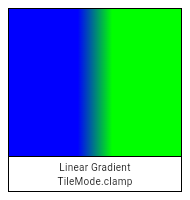 |
| 427 | /// 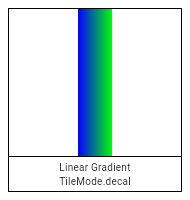 |
| 428 | /// 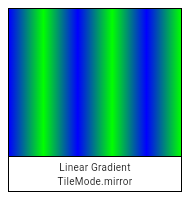 |
| 429 | /// 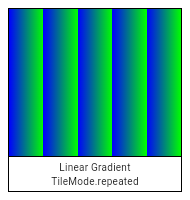 |
| 430 | final TileMode tileMode; |
| 431 | |
| 432 | @override |
| 433 | Shader createShader(Rect rect, {TextDirection? textDirection}) { |
| 434 | return ui.Gradient.linear( |
| 435 | begin.resolve(textDirection).withinRect(rect), |
| 436 | end.resolve(textDirection).withinRect(rect), |
| 437 | colors, |
| 438 | _impliedStops(), |
| 439 | tileMode, |
| 440 | _resolveTransform(rect, textDirection), |
| 441 | ); |
| 442 | } |
| 443 | |
| 444 | /// Returns a new [LinearGradient] with its colors scaled by the given factor. |
| 445 | /// |
| 446 | /// Since the alpha component of the Color is what is scaled, a factor |
| 447 | /// of 0.0 or less results in a gradient that is fully transparent. |
| 448 | @override |
| 449 | LinearGradient scale(double factor) { |
| 450 | return LinearGradient( |
| 451 | begin: begin, |
| 452 | end: end, |
| 453 | colors: colors.map<Color>((Color color) => Color.lerp(null, color, factor)!).toList(), |
| 454 | stops: stops, |
| 455 | tileMode: tileMode, |
| 456 | ); |
| 457 | } |
| 458 | |
| 459 | @override |
| 460 | Gradient? lerpFrom(Gradient? a, double t) { |
| 461 | if (a is LinearGradient?) { |
| 462 | return LinearGradient.lerp(a, this, t); |
| 463 | } |
| 464 | return super.lerpFrom(a, t); |
| 465 | } |
| 466 | |
| 467 | @override |
| 468 | Gradient? lerpTo(Gradient? b, double t) { |
| 469 | if (b is LinearGradient?) { |
| 470 | return LinearGradient.lerp(this, b, t); |
| 471 | } |
| 472 | return super.lerpTo(b, t); |
| 473 | } |
| 474 | |
| 475 | /// Linearly interpolate between two [LinearGradient]s. |
| 476 | /// |
| 477 | /// If either gradient is null, this function linearly interpolates from |
| 478 | /// a gradient that matches the other gradient in [begin], [end], [stops] and |
| 479 | /// [tileMode] and with the same [colors] but transparent (using [scale]). |
| 480 | /// |
| 481 | /// If neither gradient is null, they must have the same number of [colors]. |
| 482 | /// |
| 483 | /// The `t` argument represents a position on the timeline, with 0.0 meaning |
| 484 | /// that the interpolation has not started, returning `a` (or something |
| 485 | /// equivalent to `a`), 1.0 meaning that the interpolation has finished, |
| 486 | /// returning `b` (or something equivalent to `b`), and values in between |
| 487 | /// meaning that the interpolation is at the relevant point on the timeline |
| 488 | /// between `a` and `b`. The interpolation can be extrapolated beyond 0.0 and |
| 489 | /// 1.0, so negative values and values greater than 1.0 are valid (and can |
| 490 | /// easily be generated by curves such as [Curves.elasticInOut]). |
| 491 | /// |
| 492 | /// Values for `t` are usually obtained from an [Animation<double>], such as |
| 493 | /// an [AnimationController]. |
| 494 | static LinearGradient? lerp(LinearGradient? a, LinearGradient? b, double t) { |
| 495 | if (identical(a, b)) { |
| 496 | return a; |
| 497 | } |
| 498 | if (a == null) { |
| 499 | return b!.scale(t); |
| 500 | } |
| 501 | if (b == null) { |
| 502 | return a.scale(1.0 - t); |
| 503 | } |
| 504 | final _ColorsAndStops interpolated = _interpolateColorsAndStops( |
| 505 | a.colors, |
| 506 | a._impliedStops(), |
| 507 | b.colors, |
| 508 | b._impliedStops(), |
| 509 | t, |
| 510 | ); |
| 511 | return LinearGradient( |
| 512 | begin: AlignmentGeometry.lerp(a.begin, b.begin, t)!, |
| 513 | end: AlignmentGeometry.lerp(a.end, b.end, t)!, |
| 514 | colors: interpolated.colors, |
| 515 | stops: interpolated.stops, |
| 516 | tileMode: t < 0.5 ? a.tileMode : b.tileMode, // TODO(ianh): interpolate tile mode |
| 517 | transform: t < 0.5 ? a.transform : b.transform, |
| 518 | ); |
| 519 | } |
| 520 | |
| 521 | @override |
| 522 | bool operator ==(Object other) { |
| 523 | if (identical(this, other)) { |
| 524 | return true; |
| 525 | } |
| 526 | if (other.runtimeType != runtimeType) { |
| 527 | return false; |
| 528 | } |
| 529 | return other is LinearGradient && |
| 530 | other.begin == begin && |
| 531 | other.end == end && |
| 532 | other.tileMode == tileMode && |
| 533 | other.transform == transform && |
| 534 | listEquals<Color>(other.colors, colors) && |
| 535 | listEquals<double>(other.stops, stops); |
| 536 | } |
| 537 | |
| 538 | @override |
| 539 | int get hashCode => Object.hash( |
| 540 | begin, |
| 541 | end, |
| 542 | tileMode, |
| 543 | transform, |
| 544 | Object.hashAll(colors), |
| 545 | stops == null ? null : Object.hashAll(stops!), |
| 546 | ); |
| 547 | |
| 548 | @override |
| 549 | String toString() { |
| 550 | final List<String> description = <String>[ |
| 551 | 'begin:$begin ', |
| 552 | 'end:$end ', |
| 553 | 'colors:$colors ', |
| 554 | if (stops != null) 'stops:$stops ', |
| 555 | 'tileMode:$tileMode ', |
| 556 | if (transform != null) 'transform:$transform ', |
| 557 | ]; |
| 558 | |
| 559 | return '${objectRuntimeType(this, 'LinearGradient')} (${description.join( ', ')} )'; |
| 560 | } |
| 561 | |
| 562 | @override |
| 563 | LinearGradient withOpacity(double opacity) { |
| 564 | return LinearGradient( |
| 565 | begin: begin, |
| 566 | end: end, |
| 567 | colors: <Color>[for (final Color color in colors) color.withOpacity(opacity)], |
| 568 | stops: stops, |
| 569 | tileMode: tileMode, |
| 570 | transform: transform, |
| 571 | ); |
| 572 | } |
| 573 | } |
| 574 | |
| 575 | /// A 2D radial gradient. |
| 576 | /// |
| 577 | /// This class is used by [BoxDecoration] to represent radial gradients. This |
| 578 | /// abstracts out the arguments to the [ui.Gradient.radial] constructor from |
| 579 | /// the `dart:ui` library. |
| 580 | /// |
| 581 | /// A normal radial gradient has a [center] and a [radius]. The [center] point |
| 582 | /// corresponds to 0.0, and the ring at [radius] from the center corresponds |
| 583 | /// to 1.0. These lengths are expressed in fractions, so that the same gradient |
| 584 | /// can be reused with varying sized boxes without changing the parameters. |
| 585 | /// (This contrasts with [ui.Gradient.radial], whose arguments are expressed |
| 586 | /// in logical pixels.) |
| 587 | /// |
| 588 | /// It is also possible to create a two-point (or focal pointed) radial gradient |
| 589 | /// (which is sometimes referred to as a two point conic gradient, but is not the |
| 590 | /// same as a CSS conic gradient which corresponds to a [SweepGradient]). A [focal] |
| 591 | /// point and [focalRadius] can be specified similarly to [center] and [radius], |
| 592 | /// which will make the rendered gradient appear to be pointed or directed in the |
| 593 | /// direction of the [focal] point. This is only important if [focal] and [center] |
| 594 | /// are not equal or [focalRadius] > 0.0 (as this case is visually identical to a |
| 595 | /// normal radial gradient). One important case to avoid is having [focal] and |
| 596 | /// [center] both resolve to [Offset.zero] when [focalRadius] > 0.0. In such a case, |
| 597 | /// a valid shader cannot be created by the framework. |
| 598 | /// |
| 599 | /// The [colors] are described by a list of [Color] objects. There must be at |
| 600 | /// least two colors. The [stops] list, if specified, must have the same length |
| 601 | /// as [colors]. It specifies fractions of the radius between 0.0 and 1.0, |
| 602 | /// giving concentric rings for each color stop. If it is null, a uniform |
| 603 | /// distribution is assumed. |
| 604 | /// |
| 605 | /// The region of the canvas beyond [radius] from the [center] is colored |
| 606 | /// according to [tileMode]. |
| 607 | /// |
| 608 | /// Typically this class is used with [BoxDecoration], which does the painting. |
| 609 | /// To use a [RadialGradient] to paint on a canvas directly, see [createShader]. |
| 610 | /// |
| 611 | /// {@tool snippet} |
| 612 | /// |
| 613 | /// This function draws a gradient that looks like a sun in a blue sky. |
| 614 | /// |
| 615 | /// ```dart |
| 616 | /// void paintSky(Canvas canvas, Rect rect) { |
| 617 | /// const RadialGradient gradient = RadialGradient( |
| 618 | /// center: Alignment(0.7, -0.6), // near the top right |
| 619 | /// radius: 0.2, |
| 620 | /// colors: <Color>[ |
| 621 | /// Color(0xFFFFFF00), // yellow sun |
| 622 | /// Color(0xFF0099FF), // blue sky |
| 623 | /// ], |
| 624 | /// stops: <double>[0.4, 1.0], |
| 625 | /// ); |
| 626 | /// // rect is the area we are painting over |
| 627 | /// final Paint paint = Paint() |
| 628 | /// ..shader = gradient.createShader(rect); |
| 629 | /// canvas.drawRect(rect, paint); |
| 630 | /// } |
| 631 | /// ``` |
| 632 | /// {@end-tool} |
| 633 | /// |
| 634 | /// See also: |
| 635 | /// |
| 636 | /// * [LinearGradient], which displays a gradient in parallel lines, and has an |
| 637 | /// example which shows a different way to use [Gradient] objects. |
| 638 | /// * [SweepGradient], which displays a gradient in a sweeping arc around a |
| 639 | /// center point. |
| 640 | /// * [BoxDecoration], which can take a [RadialGradient] in its |
| 641 | /// [BoxDecoration.gradient] property. |
| 642 | /// * [CustomPainter], which shows how to use the above sample code in a custom |
| 643 | /// painter. |
| 644 | class RadialGradient extends Gradient { |
| 645 | /// Creates a radial gradient. |
| 646 | /// |
| 647 | /// If [stops] is non-null, it must have the same length as [colors]. |
| 648 | const RadialGradient({ |
| 649 | this.center = Alignment.center, |
| 650 | this.radius = 0.5, |
| 651 | required super.colors, |
| 652 | super.stops, |
| 653 | this.tileMode = TileMode.clamp, |
| 654 | this.focal, |
| 655 | this.focalRadius = 0.0, |
| 656 | super.transform, |
| 657 | }); |
| 658 | |
| 659 | /// The center of the gradient, as an offset into the (-1.0, -1.0) x (1.0, 1.0) |
| 660 | /// square describing the gradient which will be mapped onto the paint box. |
| 661 | /// |
| 662 | /// For example, an alignment of (0.0, 0.0) will place the radial |
| 663 | /// gradient in the center of the box. |
| 664 | /// |
| 665 | /// If this is an [Alignment], then it is expressed as a vector from |
| 666 | /// coordinate (0.0, 0.0), in a coordinate space that maps the center of the |
| 667 | /// paint box at (0.0, 0.0) and the bottom right at (1.0, 1.0). |
| 668 | /// |
| 669 | /// It can also be an [AlignmentDirectional], where the start is the left in |
| 670 | /// left-to-right contexts and the right in right-to-left contexts. If a |
| 671 | /// text-direction-dependent value is provided here, then the [createShader] |
| 672 | /// method will need to be given a [TextDirection]. |
| 673 | final AlignmentGeometry center; |
| 674 | |
| 675 | /// The radius of the gradient, as a fraction of the shortest side |
| 676 | /// of the paint box. |
| 677 | /// |
| 678 | /// For example, if a radial gradient is painted on a box that is |
| 679 | /// 100.0 pixels wide and 200.0 pixels tall, then a radius of 1.0 |
| 680 | /// will place the 1.0 stop at 100.0 pixels from the [center]. |
| 681 | final double radius; |
| 682 | |
| 683 | /// How this gradient should tile the plane beyond the outer ring at [radius] |
| 684 | /// pixels from the [center]. |
| 685 | /// |
| 686 | /// For details, see [TileMode]. |
| 687 | /// |
| 688 | /// 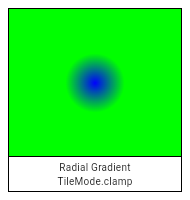 |
| 689 | /// 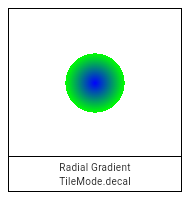 |
| 690 | /// 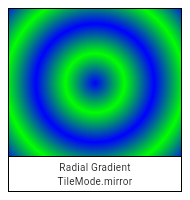 |
| 691 | /// 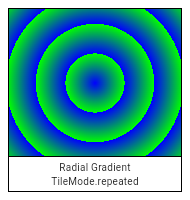 |
| 692 | /// |
| 693 | /// 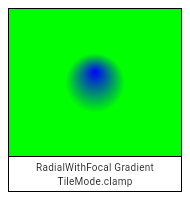 |
| 694 | /// 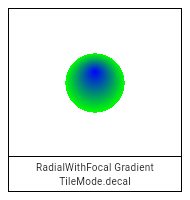 |
| 695 | /// 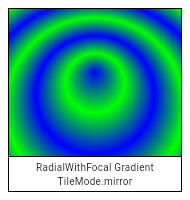 |
| 696 | /// 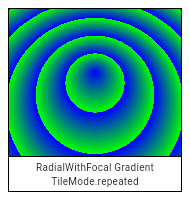 |
| 697 | final TileMode tileMode; |
| 698 | |
| 699 | /// The focal point of the gradient. If specified, the gradient will appear |
| 700 | /// to be focused along the vector from [center] to focal. |
| 701 | /// |
| 702 | /// See [center] for a description of how the coordinates are mapped. |
| 703 | /// |
| 704 | /// If this value is specified and [focalRadius] > 0.0, care should be taken |
| 705 | /// to ensure that either this value or [center] will not both resolve to |
| 706 | /// [Offset.zero], which would fail to create a valid gradient. |
| 707 | final AlignmentGeometry? focal; |
| 708 | |
| 709 | /// The radius of the focal point of gradient, as a fraction of the shortest |
| 710 | /// side of the paint box. |
| 711 | /// |
| 712 | /// For example, if a radial gradient is painted on a box that is |
| 713 | /// 100.0 pixels wide and 200.0 pixels tall, then a radius of 1.0 |
| 714 | /// will place the 1.0 stop at 100.0 pixels from the [focal] point. |
| 715 | /// |
| 716 | /// If this value is specified and is greater than 0.0, either [focal] or |
| 717 | /// [center] must not resolve to [Offset.zero], which would fail to create |
| 718 | /// a valid gradient. |
| 719 | final double focalRadius; |
| 720 | |
| 721 | @override |
| 722 | Shader createShader(Rect rect, {TextDirection? textDirection}) { |
| 723 | return ui.Gradient.radial( |
| 724 | center.resolve(textDirection).withinRect(rect), |
| 725 | radius * rect.shortestSide, |
| 726 | colors, |
| 727 | _impliedStops(), |
| 728 | tileMode, |
| 729 | _resolveTransform(rect, textDirection), |
| 730 | focal?.resolve(textDirection).withinRect(rect), |
| 731 | focalRadius * rect.shortestSide, |
| 732 | ); |
| 733 | } |
| 734 | |
| 735 | /// Returns a new [RadialGradient] with its colors scaled by the given factor. |
| 736 | /// |
| 737 | /// Since the alpha component of the Color is what is scaled, a factor |
| 738 | /// of 0.0 or less results in a gradient that is fully transparent. |
| 739 | @override |
| 740 | RadialGradient scale(double factor) { |
| 741 | return RadialGradient( |
| 742 | center: center, |
| 743 | radius: radius, |
| 744 | colors: colors.map<Color>((Color color) => Color.lerp(null, color, factor)!).toList(), |
| 745 | stops: stops, |
| 746 | tileMode: tileMode, |
| 747 | focal: focal, |
| 748 | focalRadius: focalRadius, |
| 749 | ); |
| 750 | } |
| 751 | |
| 752 | @override |
| 753 | Gradient? lerpFrom(Gradient? a, double t) { |
| 754 | if (a is RadialGradient?) { |
| 755 | return RadialGradient.lerp(a, this, t); |
| 756 | } |
| 757 | return super.lerpFrom(a, t); |
| 758 | } |
| 759 | |
| 760 | @override |
| 761 | Gradient? lerpTo(Gradient? b, double t) { |
| 762 | if (b is RadialGradient?) { |
| 763 | return RadialGradient.lerp(this, b, t); |
| 764 | } |
| 765 | return super.lerpTo(b, t); |
| 766 | } |
| 767 | |
| 768 | /// Linearly interpolate between two [RadialGradient]s. |
| 769 | /// |
| 770 | /// If either gradient is null, this function linearly interpolates from |
| 771 | /// a gradient that matches the other gradient in [center], [radius], [stops] and |
| 772 | /// [tileMode] and with the same [colors] but transparent (using [scale]). |
| 773 | /// |
| 774 | /// If neither gradient is null, they must have the same number of [colors]. |
| 775 | /// |
| 776 | /// The `t` argument represents a position on the timeline, with 0.0 meaning |
| 777 | /// that the interpolation has not started, returning `a` (or something |
| 778 | /// equivalent to `a`), 1.0 meaning that the interpolation has finished, |
| 779 | /// returning `b` (or something equivalent to `b`), and values in between |
| 780 | /// meaning that the interpolation is at the relevant point on the timeline |
| 781 | /// between `a` and `b`. The interpolation can be extrapolated beyond 0.0 and |
| 782 | /// 1.0, so negative values and values greater than 1.0 are valid (and can |
| 783 | /// easily be generated by curves such as [Curves.elasticInOut]). |
| 784 | /// |
| 785 | /// Values for `t` are usually obtained from an [Animation<double>], such as |
| 786 | /// an [AnimationController]. |
| 787 | static RadialGradient? lerp(RadialGradient? a, RadialGradient? b, double t) { |
| 788 | if (identical(a, b)) { |
| 789 | return a; |
| 790 | } |
| 791 | if (a == null) { |
| 792 | return b!.scale(t); |
| 793 | } |
| 794 | if (b == null) { |
| 795 | return a.scale(1.0 - t); |
| 796 | } |
| 797 | final _ColorsAndStops interpolated = _interpolateColorsAndStops( |
| 798 | a.colors, |
| 799 | a._impliedStops(), |
| 800 | b.colors, |
| 801 | b._impliedStops(), |
| 802 | t, |
| 803 | ); |
| 804 | return RadialGradient( |
| 805 | center: AlignmentGeometry.lerp(a.center, b.center, t)!, |
| 806 | radius: math.max(0.0, ui.lerpDouble(a.radius, b.radius, t)!), |
| 807 | colors: interpolated.colors, |
| 808 | stops: interpolated.stops, |
| 809 | tileMode: t < 0.5 ? a.tileMode : b.tileMode, // TODO(ianh): interpolate tile mode |
| 810 | focal: AlignmentGeometry.lerp(a.focal, b.focal, t), |
| 811 | focalRadius: math.max(0.0, ui.lerpDouble(a.focalRadius, b.focalRadius, t)!), |
| 812 | transform: t < 0.5 ? a.transform : b.transform, |
| 813 | ); |
| 814 | } |
| 815 | |
| 816 | @override |
| 817 | bool operator ==(Object other) { |
| 818 | if (identical(this, other)) { |
| 819 | return true; |
| 820 | } |
| 821 | if (other.runtimeType != runtimeType) { |
| 822 | return false; |
| 823 | } |
| 824 | return other is RadialGradient && |
| 825 | other.center == center && |
| 826 | other.radius == radius && |
| 827 | other.tileMode == tileMode && |
| 828 | other.transform == transform && |
| 829 | listEquals<Color>(other.colors, colors) && |
| 830 | listEquals<double>(other.stops, stops) && |
| 831 | other.focal == focal && |
| 832 | other.focalRadius == focalRadius; |
| 833 | } |
| 834 | |
| 835 | @override |
| 836 | int get hashCode => Object.hash( |
| 837 | center, |
| 838 | radius, |
| 839 | tileMode, |
| 840 | transform, |
| 841 | Object.hashAll(colors), |
| 842 | stops == null ? null : Object.hashAll(stops!), |
| 843 | focal, |
| 844 | focalRadius, |
| 845 | ); |
| 846 | |
| 847 | @override |
| 848 | String toString() { |
| 849 | final List<String> description = <String>[ |
| 850 | 'center:$center ', |
| 851 | 'radius:${debugFormatDouble(radius)} ', |
| 852 | 'colors:$colors ', |
| 853 | if (stops != null) 'stops:$stops ', |
| 854 | 'tileMode:$tileMode ', |
| 855 | if (focal != null) 'focal:$focal ', |
| 856 | 'focalRadius:${debugFormatDouble(focalRadius)} ', |
| 857 | if (transform != null) 'transform:$transform ', |
| 858 | ]; |
| 859 | |
| 860 | return '${objectRuntimeType(this, 'RadialGradient')} (${description.join( ', ')} )'; |
| 861 | } |
| 862 | |
| 863 | @override |
| 864 | RadialGradient withOpacity(double opacity) { |
| 865 | return RadialGradient( |
| 866 | center: center, |
| 867 | radius: radius, |
| 868 | colors: <Color>[for (final Color color in colors) color.withOpacity(opacity)], |
| 869 | stops: stops, |
| 870 | tileMode: tileMode, |
| 871 | focal: focal, |
| 872 | focalRadius: focalRadius, |
| 873 | transform: transform, |
| 874 | ); |
| 875 | } |
| 876 | } |
| 877 | |
| 878 | /// A 2D sweep gradient. |
| 879 | /// |
| 880 | /// This class is used by [BoxDecoration] to represent sweep gradients. This |
| 881 | /// abstracts out the arguments to the [ui.Gradient.sweep] constructor from |
| 882 | /// the `dart:ui` library. |
| 883 | /// |
| 884 | /// A gradient has a [center], a [startAngle], and an [endAngle]. The [startAngle] |
| 885 | /// corresponds to 0.0, and the [endAngle] corresponds to 1.0. These angles are |
| 886 | /// expressed in radians. |
| 887 | /// |
| 888 | /// The [colors] are described by a list of [Color] objects. There must be at |
| 889 | /// least two colors. The [stops] list, if specified, must have the same length |
| 890 | /// as [colors]. It specifies fractions of the vector from start to end, between |
| 891 | /// 0.0 and 1.0, for each color. If it is null, a uniform distribution is |
| 892 | /// assumed. |
| 893 | /// |
| 894 | /// The region of the canvas before [startAngle] and after [endAngle] is colored |
| 895 | /// according to [tileMode]. |
| 896 | /// |
| 897 | /// Typically this class is used with [BoxDecoration], which does the painting. |
| 898 | /// To use a [SweepGradient] to paint on a canvas directly, see [createShader]. |
| 899 | /// |
| 900 | /// {@tool snippet} |
| 901 | /// |
| 902 | /// This sample draws a different color in each quadrant. |
| 903 | /// |
| 904 | /// ```dart |
| 905 | /// Container( |
| 906 | /// decoration: const BoxDecoration( |
| 907 | /// gradient: SweepGradient( |
| 908 | /// center: FractionalOffset.center, |
| 909 | /// colors: <Color>[ |
| 910 | /// Color(0xFF4285F4), // blue |
| 911 | /// Color(0xFF34A853), // green |
| 912 | /// Color(0xFFFBBC05), // yellow |
| 913 | /// Color(0xFFEA4335), // red |
| 914 | /// Color(0xFF4285F4), // blue again to seamlessly transition to the start |
| 915 | /// ], |
| 916 | /// stops: <double>[0.0, 0.25, 0.5, 0.75, 1.0], |
| 917 | /// ), |
| 918 | /// ) |
| 919 | /// ) |
| 920 | /// ``` |
| 921 | /// {@end-tool} |
| 922 | /// |
| 923 | /// {@tool snippet} |
| 924 | /// |
| 925 | /// This sample takes the above gradient and rotates it by `math.pi/4` radians, |
| 926 | /// i.e. 45 degrees. |
| 927 | /// |
| 928 | /// ```dart |
| 929 | /// Container( |
| 930 | /// decoration: const BoxDecoration( |
| 931 | /// gradient: SweepGradient( |
| 932 | /// center: FractionalOffset.center, |
| 933 | /// colors: <Color>[ |
| 934 | /// Color(0xFF4285F4), // blue |
| 935 | /// Color(0xFF34A853), // green |
| 936 | /// Color(0xFFFBBC05), // yellow |
| 937 | /// Color(0xFFEA4335), // red |
| 938 | /// Color(0xFF4285F4), // blue again to seamlessly transition to the start |
| 939 | /// ], |
| 940 | /// stops: <double>[0.0, 0.25, 0.5, 0.75, 1.0], |
| 941 | /// transform: GradientRotation(math.pi/4), |
| 942 | /// ), |
| 943 | /// ), |
| 944 | /// ) |
| 945 | /// ``` |
| 946 | /// {@end-tool} |
| 947 | /// |
| 948 | /// See also: |
| 949 | /// |
| 950 | /// * [LinearGradient], which displays a gradient in parallel lines, and has an |
| 951 | /// example which shows a different way to use [Gradient] objects. |
| 952 | /// * [RadialGradient], which displays a gradient in concentric circles, and |
| 953 | /// has an example which shows a different way to use [Gradient] objects. |
| 954 | /// * [BoxDecoration], which can take a [SweepGradient] in its |
| 955 | /// [BoxDecoration.gradient] property. |
| 956 | class SweepGradient extends Gradient { |
| 957 | /// Creates a sweep gradient. |
| 958 | /// |
| 959 | /// If [stops] is non-null, it must have the same length as [colors]. |
| 960 | const SweepGradient({ |
| 961 | this.center = Alignment.center, |
| 962 | this.startAngle = 0.0, |
| 963 | this.endAngle = math.pi * 2, |
| 964 | required super.colors, |
| 965 | super.stops, |
| 966 | this.tileMode = TileMode.clamp, |
| 967 | super.transform, |
| 968 | }); |
| 969 | |
| 970 | /// The center of the gradient, as an offset into the (-1.0, -1.0) x (1.0, 1.0) |
| 971 | /// square describing the gradient which will be mapped onto the paint box. |
| 972 | /// |
| 973 | /// For example, an alignment of (0.0, 0.0) will place the sweep |
| 974 | /// gradient in the center of the box. |
| 975 | /// |
| 976 | /// If this is an [Alignment], then it is expressed as a vector from |
| 977 | /// coordinate (0.0, 0.0), in a coordinate space that maps the center of the |
| 978 | /// paint box at (0.0, 0.0) and the bottom right at (1.0, 1.0). |
| 979 | /// |
| 980 | /// It can also be an [AlignmentDirectional], where the start is the left in |
| 981 | /// left-to-right contexts and the right in right-to-left contexts. If a |
| 982 | /// text-direction-dependent value is provided here, then the [createShader] |
| 983 | /// method will need to be given a [TextDirection]. |
| 984 | final AlignmentGeometry center; |
| 985 | |
| 986 | /// The angle in radians at which stop 0.0 of the gradient is placed. |
| 987 | /// |
| 988 | /// Defaults to 0.0. |
| 989 | final double startAngle; |
| 990 | |
| 991 | /// The angle in radians at which stop 1.0 of the gradient is placed. |
| 992 | /// |
| 993 | /// Defaults to math.pi * 2. |
| 994 | final double endAngle; |
| 995 | |
| 996 | /// How this gradient should tile the plane beyond in the region before |
| 997 | /// [startAngle] and after [endAngle]. |
| 998 | /// |
| 999 | /// For details, see [TileMode]. |
| 1000 | /// |
| 1001 | /// 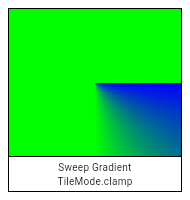 |
| 1002 | /// 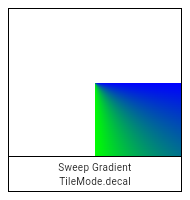 |
| 1003 | /// 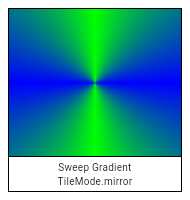 |
| 1004 | /// 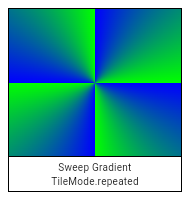 |
| 1005 | final TileMode tileMode; |
| 1006 | |
| 1007 | @override |
| 1008 | Shader createShader(Rect rect, {TextDirection? textDirection}) { |
| 1009 | return ui.Gradient.sweep( |
| 1010 | center.resolve(textDirection).withinRect(rect), |
| 1011 | colors, |
| 1012 | _impliedStops(), |
| 1013 | tileMode, |
| 1014 | startAngle, |
| 1015 | endAngle, |
| 1016 | _resolveTransform(rect, textDirection), |
| 1017 | ); |
| 1018 | } |
| 1019 | |
| 1020 | /// Returns a new [SweepGradient] with its colors scaled by the given factor. |
| 1021 | /// |
| 1022 | /// Since the alpha component of the Color is what is scaled, a factor |
| 1023 | /// of 0.0 or less results in a gradient that is fully transparent. |
| 1024 | @override |
| 1025 | SweepGradient scale(double factor) { |
| 1026 | return SweepGradient( |
| 1027 | center: center, |
| 1028 | startAngle: startAngle, |
| 1029 | endAngle: endAngle, |
| 1030 | colors: colors.map<Color>((Color color) => Color.lerp(null, color, factor)!).toList(), |
| 1031 | stops: stops, |
| 1032 | tileMode: tileMode, |
| 1033 | ); |
| 1034 | } |
| 1035 | |
| 1036 | @override |
| 1037 | Gradient? lerpFrom(Gradient? a, double t) { |
| 1038 | if (a is SweepGradient?) { |
| 1039 | return SweepGradient.lerp(a, this, t); |
| 1040 | } |
| 1041 | return super.lerpFrom(a, t); |
| 1042 | } |
| 1043 | |
| 1044 | @override |
| 1045 | Gradient? lerpTo(Gradient? b, double t) { |
| 1046 | if (b is SweepGradient?) { |
| 1047 | return SweepGradient.lerp(this, b, t); |
| 1048 | } |
| 1049 | return super.lerpTo(b, t); |
| 1050 | } |
| 1051 | |
| 1052 | /// Linearly interpolate between two [SweepGradient]s. |
| 1053 | /// |
| 1054 | /// If either gradient is null, then the non-null gradient is returned with |
| 1055 | /// its color scaled in the same way as the [scale] function. |
| 1056 | /// |
| 1057 | /// If neither gradient is null, they must have the same number of [colors]. |
| 1058 | /// |
| 1059 | /// The `t` argument represents a position on the timeline, with 0.0 meaning |
| 1060 | /// that the interpolation has not started, returning `a` (or something |
| 1061 | /// equivalent to `a`), 1.0 meaning that the interpolation has finished, |
| 1062 | /// returning `b` (or something equivalent to `b`), and values in between |
| 1063 | /// meaning that the interpolation is at the relevant point on the timeline |
| 1064 | /// between `a` and `b`. The interpolation can be extrapolated beyond 0.0 and |
| 1065 | /// 1.0, so negative values and values greater than 1.0 are valid (and can |
| 1066 | /// easily be generated by curves such as [Curves.elasticInOut]). |
| 1067 | /// |
| 1068 | /// Values for `t` are usually obtained from an [Animation<double>], such as |
| 1069 | /// an [AnimationController]. |
| 1070 | static SweepGradient? lerp(SweepGradient? a, SweepGradient? b, double t) { |
| 1071 | if (identical(a, b)) { |
| 1072 | return a; |
| 1073 | } |
| 1074 | if (a == null) { |
| 1075 | return b!.scale(t); |
| 1076 | } |
| 1077 | if (b == null) { |
| 1078 | return a.scale(1.0 - t); |
| 1079 | } |
| 1080 | final _ColorsAndStops interpolated = _interpolateColorsAndStops( |
| 1081 | a.colors, |
| 1082 | a._impliedStops(), |
| 1083 | b.colors, |
| 1084 | b._impliedStops(), |
| 1085 | t, |
| 1086 | ); |
| 1087 | return SweepGradient( |
| 1088 | center: AlignmentGeometry.lerp(a.center, b.center, t)!, |
| 1089 | startAngle: math.max(0.0, ui.lerpDouble(a.startAngle, b.startAngle, t)!), |
| 1090 | endAngle: math.max(0.0, ui.lerpDouble(a.endAngle, b.endAngle, t)!), |
| 1091 | colors: interpolated.colors, |
| 1092 | stops: interpolated.stops, |
| 1093 | tileMode: t < 0.5 ? a.tileMode : b.tileMode, // TODO(ianh): interpolate tile mode |
| 1094 | transform: t < 0.5 ? a.transform : b.transform, |
| 1095 | ); |
| 1096 | } |
| 1097 | |
| 1098 | @override |
| 1099 | bool operator ==(Object other) { |
| 1100 | if (identical(this, other)) { |
| 1101 | return true; |
| 1102 | } |
| 1103 | if (other.runtimeType != runtimeType) { |
| 1104 | return false; |
| 1105 | } |
| 1106 | return other is SweepGradient && |
| 1107 | other.center == center && |
| 1108 | other.startAngle == startAngle && |
| 1109 | other.endAngle == endAngle && |
| 1110 | other.tileMode == tileMode && |
| 1111 | other.transform == transform && |
| 1112 | listEquals<Color>(other.colors, colors) && |
| 1113 | listEquals<double>(other.stops, stops); |
| 1114 | } |
| 1115 | |
| 1116 | @override |
| 1117 | int get hashCode => Object.hash( |
| 1118 | center, |
| 1119 | startAngle, |
| 1120 | endAngle, |
| 1121 | tileMode, |
| 1122 | transform, |
| 1123 | Object.hashAll(colors), |
| 1124 | stops == null ? null : Object.hashAll(stops!), |
| 1125 | ); |
| 1126 | |
| 1127 | @override |
| 1128 | String toString() { |
| 1129 | final List<String> description = <String>[ |
| 1130 | 'center:$center ', |
| 1131 | 'startAngle:${debugFormatDouble(startAngle)} ', |
| 1132 | 'endAngle:${debugFormatDouble(endAngle)} ', |
| 1133 | 'colors:$colors ', |
| 1134 | if (stops != null) 'stops:$stops ', |
| 1135 | 'tileMode:$tileMode ', |
| 1136 | if (transform != null) 'transform:$transform ', |
| 1137 | ]; |
| 1138 | |
| 1139 | return '${objectRuntimeType(this, 'SweepGradient')} (${description.join( ', ')} )'; |
| 1140 | } |
| 1141 | |
| 1142 | @override |
| 1143 | SweepGradient withOpacity(double opacity) { |
| 1144 | return SweepGradient( |
| 1145 | center: center, |
| 1146 | startAngle: startAngle, |
| 1147 | endAngle: endAngle, |
| 1148 | colors: <Color>[for (final Color color in colors) color.withOpacity(opacity)], |
| 1149 | stops: stops, |
| 1150 | tileMode: tileMode, |
| 1151 | transform: transform, |
| 1152 | ); |
| 1153 | } |
| 1154 | } |
| 1155 |
Definitions
- _ColorsAndStops
- _ColorsAndStops
- _sample
- _interpolateColorsAndStops
- GradientTransform
- GradientTransform
- transform
- GradientRotation
- GradientRotation
- transform
- ==
- hashCode
- toString
- Gradient
- Gradient
- _impliedStops
- createShader
- scale
- withOpacity
- lerpFrom
- lerpTo
- lerp
- _resolveTransform
- LinearGradient
- LinearGradient
- createShader
- scale
- lerpFrom
- lerpTo
- lerp
- ==
- hashCode
- toString
- withOpacity
- RadialGradient
- RadialGradient
- createShader
- scale
- lerpFrom
- lerpTo
- lerp
- ==
- hashCode
- toString
- withOpacity
- SweepGradient
- SweepGradient
- createShader
- scale
- lerpFrom
- lerpTo
- lerp
- ==
- hashCode
- toString
Learn more about Flutter for embedded and desktop on industrialflutter.com
